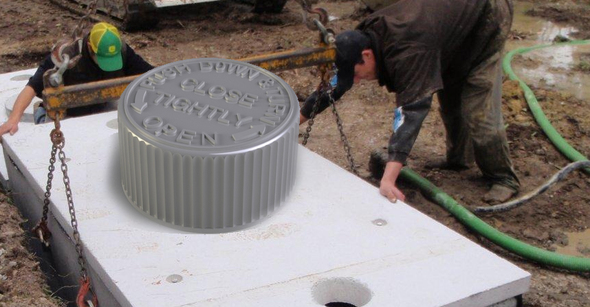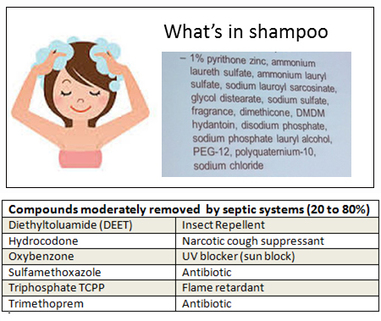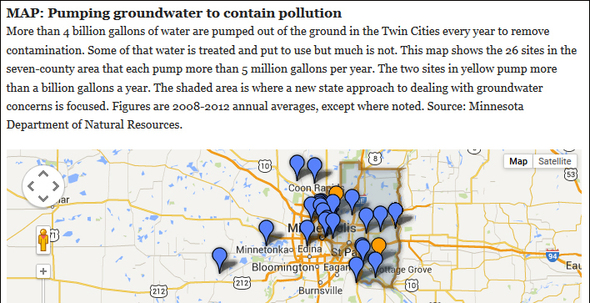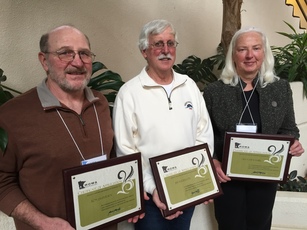
 There's an old saying, you are
what you eat; and to some degree the same can be said about your septic
system. "If you are on drugs, so is your septic system," says John
Buchanan (at right), a professor at the University of Tennessee who was one of the
keynote presenters at the annual Minnesota Onsite Wastewater Association
(MOWA) convention held in Minneapolis in January. And the problem with some of
the drugs and compounds going into septic systems is they are harder to
break down than contaminants normally found in human waste.
"Many of our pharmaceuticals are designed to be difficult to biodegrade. In order to be active within our bodies, pharmaceuticals must survive going through the liver—perhaps the most powerful treatment plant devised by nature," Buchanan said. "The liver has many enzymatic pathways that can breakdown complex compounds for easy removal by the kidneys. If these products are difficult for the liver to breakdown, then they will be difficult for the septic system to breakdown."
Adding to the problem is the fact that even very small amounts of certain
compounds can have significant effects in humans. These trace amounts
that can affect human health are often measured in micrograms or parts per billion (ppb), while pollutants most commonly dealt with
have human health limits measured in milligrams or parts per million (ppm). For this reason many compounds have been identified as contaminants
of emerging concern because until recently we did not have tools
available able to detect much less measure them.
|
 Buchanan
said this list of compounds include those not only associated with
medications such as chemotherapy drugs but a long list of ingredients found in many of today's consumer products. He mentioned, for example,
triclosan, a common ingrediant in some anti-bacterial products. A
2003-2004 study showed that 75 percent of
those tested had triclosan detected in their urine.(Minnesota
has banned the use of triclosan-containing products in state agencies).
What to do about the issue
Professor
Buchanan said future treatment options for compounds of concern will
vary. Municipal wastewater treatment facilities may focus on adding
additional energy to the system in order to break down these compounds.
This could include adding ultraviolet light as even exposure to sunlight
can degrade many compounds that don't break down well in existing
plants. Adding ozone or other strong oxidizers can also break down these
compounds.
When it comes to septic systems, Buchanan
suggested states could begin to consider simple techniques that could
get more sophisticated as we gain a better understanding of the
challenges we face in keeping our drinking water and surface waters clean of potentially harmful
compounds.
- Those with septic systems should take extra medications to collection sites, not wash them down the drain or toilet.
- Don't pour pesticides down the drain.
- Minimize the use of antibacterial soaps, cleaners and bleach that stress/kill helpful bacteria in the septic system.
- Increased
system maintenance may be required if a family is taking certain strong
drugs such as chemotherapy drugs. The tank may need to be pumped more
often to remove solids that are accumulating rapidy due to the loss of
benficial bacteria. If the system becomes too toxic for bacteria, the
septic tank could be used as a holding tank during the course of a
specific drug treatment and then pumped.
- Design
changes may be necessary to protect drainfields such as additional
effluent screens to limit solids exiting the tank or adding an
additional septic tank or pre-treatment device.
Nursing homes, animal clinics of special concern
Buchanan
said special consideration needs to be given to septic systems that
serve assisted living centers, nursing homes and animal clinics
where it is especially likely pharmaceuticals are getting washed down
the drain. In these cases the time may come when septic system designs
will need to account for more than just hydraulic loading. They will
also need to focus additional attention on organic loading, especially
the ratio of biological oxygen demand to chemical oxygen demand.
"Septic
systems and soil have tremedous potential to capture trace organic
compounds," Buchanan said. "But this system is not bulletproof. Someday
we may have to evaluate trace organics in septage."
A copy of professor Buchanan's presentation is available on the MOWA website.
|

 Most people
have no idea where the water that runs from their tap comes from, or
where it goes, but that is changing because now, in some places, there
is no water coming from the tap and in other places what is coming from
the tap is polluted. And we're just now scratching the surface of this problem and what lies beneath it. That's the message Minnesota Pubic Radio
(MPR) editor Dave Peters (pictured at right) shared in his keynote address at the MOWA
conference.
In a series of "Beneath the Surface" stories, MPR highlighted a number of changes drawing attention to groundwater issues in Minnesota and across the country:
- Nitrates from farming operations contaminating drinking water supplies
- Cities considering reusing wastewater for watering golf courses, equipment, possibly even for drinking water
- Farmers, residents, others competing for dwindling groundwater resources
- Contaminants of concern showing up in groundwater, etc.
"Working on this series showed us that water is a much bigger issue than we anticipated when we started," Peters said.
While
the issues with groundwater are national, they are being addressed at
the local level. "The concerns are different in different areas," Peters
said. "In southwest Minnesota there are concerns about nitrates in the
groundwater... in White Bear Lake there is the concern over dropping
water levels in the lake."
|
Peters said bringing people together as was done in White Bear Lake to understand the problems they face and what should be done needs to happen everywhere. "We are early on in this process and it can be a bit bureaucratic but it's good that we are starting to learn a new way of relating to water... . MOWA members can help with that, help the people they work with to have a closer, more thoughtful relationship with the water they use."
By Nicole Blasing
Once an inspector completes an inspection of an existing SSTS, Minnesota requires the inspector to submit the completed inspection form to the local unit of government (LGU) and the property owner within 15 days of the day of the inspection.This requirement allows the LGU to follow up appropriately if the system is determined to be noncompliant or an imminent threat to public health (ITPH). To ensure compliance with this rule follow these steps:
- Conduct the SSTS inspection on site and fill out the Compliance Inspection Form (Example: you were on site and conducted the inspection on May 5, 2015).
- Submit the completed Compliance Inspection Form to the LGU and the property owner by 15 days after the day you conducted the inspection on site (Example: the LGU and the property owner received the Compliance Inspection From on or before May. 20, 2015).
During the period October - December, 2014, the MPCA completed 58 enforcement cases in 34 counties. Six of the 58 MPCA cases (10 percent) were SSTS related. They were located in Fergus Falls, Brainerd, Baxter, Isanti, Duluth, and Breckenridge.
Financial penalties totaling $8,350 for the six cases ranged from $650 to $2,750. More information can be found on the MPCA’s website.
 The MPCA
SSTS program is nothing without its stakeholders, says MPCA staffer Nick
Haig. "We are fortunate to have committed partners in the delivery and
continuous improvement of this program. We have tallied the
contributions of over 50 individuals who have given at least
2,000 hours of their time to our program in 2014 by serving on the SSTS
Advisory Committee, the Technical Advisory Panel, the Implementation and
Enforcement Task Force, and our recent Need to Know and Exam
Development efforts."
Haig
said this contribution is the equivalent of one full time employee, not
just any employee "but a super FTE with over 50 brains and different
perspectives and viewpoints."
Those who volunteered
their efforts in 2014 will be receiving recognition from MPCA
Commissioner John Linc Stine. There are volunteering opportunities
available for 2015. If you are interested in exploring what these are,
contact Aaron Jensen or Nick Haig.
|
 By Sara Heger, University of Minnesota Onsite Septic Program
The Minnesota Onsite Wastewater Association (MOWA) awarded three lifetime achievement awards at their annual conference in January. This award recognizes individuals whose careers in the field of onsite wastewater treatment are exemplary, with outstanding service, dedication and accomplishment for MOWA.
Gretchen Sabel
Gretchen Sabel retired this past summer from the MPCA after 36 years
of state service. She committed nearly four decades of her life to
environmental protection. She was on the team that helped pass the
historic Minnesota Groundwater Projection act in 1989. For nearly 25
years she was a “founding mother” of the Minnesota septic system program as we
know it today. Her unwavering support for local programs has resulted in
millions of dollars in assistance and development of 250 local
programs. Gretchen came from Pittsburgh, PA, where the groundwater was
contaminated and a polluted environment was a foregone conclusion.
Coming to Minnesota, Gretchen was proud to live in a state that didn’t
tolerate that. She dedicated her career to that premise.
Jim Anderson
Jim Anderson, (pictured center) has been conducting research and providing education on septic systems since 1971. Jim and Roger Machmeier started the Onsite Sewage Treatment Program (OSTP) at the University of Minnesota resulting in one of the best education and certification programs in the US. Jim’s soils expertise, combined with Roger’s engineering knowledge created a program which successfully trains installers, designers, inspectors and service providers. In addition, he helped develop and update Minnesota Rules 30 years as chair of the Minnesota Septic System Advisory Committee. Presenting the award, OSTP’s Sara Heger said: “Jim’s example taught the septic industry three important things: 1) the value of getting your hands dirty, 2) the value of belonging to a state association and 3) the impact that one person can make.”
Ron Jaspersen
Ron (pictured at left) has served the onsite community for many decades as a precast tank manufacturer and through his efforts to improve the industry. His standard for fairness, equity and getting it right for all parties is demonstrated daily through delivering the highest quality products and service. He has donated an immeasurable amount of time over the years to work on critical issues that include association finances and bylaws, state septic code and policy, and state statutes. He has applied his penchant for detail to these efforts while working quietly and without fanfare. His positive impacts may be largely unseen but have had major benefit for people served by septic systems.
|
|